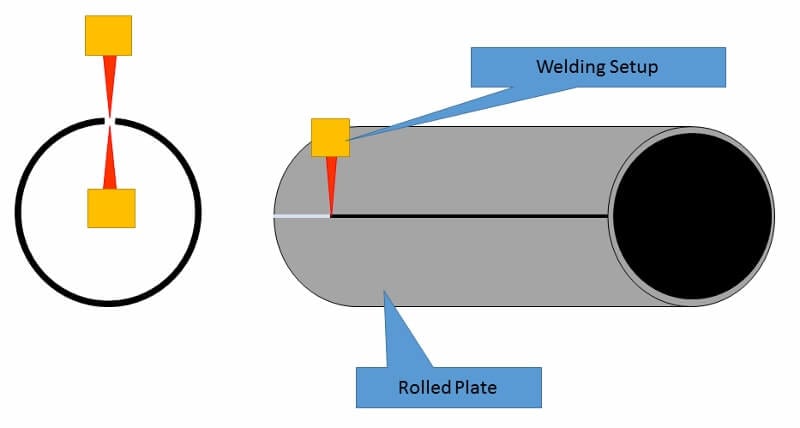In this video, you will learn about Welded Pipe Manufacturing Processes such as SAW, ERW, EFW & HFW.
Welded Pipes are manufactured from plates or continuous Coil or strips. To manufacture welded pipe, first, Plate or coil is rolled in the circular section with the help of a plate bending machine or by a roller in the case of a continuous process.
Once the circular section is rolled from the plate, in the second step pipe is welded with the help of a welding setup. Using an appropriate welding method, a pipe can be welded with or without filler material.
Welded pipes are cheaper than seamless ones and also weak due to the weld joint. The welded pipe can be manufactured in large sizes without any upper restriction. Welded pipe with filler material can be used in the manufacturing of long radius bends and elbows.
Here, I have shown you the forming of the plate by the rolling machine. In this method, the plate is placed between the rollers. The plate is formed in circular sections by gradually applying the load on the top roller and rotating the plate.
This method is used for manufacturing of higher thickness SAW pipes. Instead of the roller, point pressing method which also known as UO methods can also be used to form a circular section from the plate. UO means; first, you made u shape & then the O shape.
SAW Welded Pipe Manufacturing Method
In a single seam SAW pipe, the wedding is done with the help of the submerged arc welding process. In this method, a welding arc is submerged in welding flux. A Continues solid filler wire is fed from the outside. The pipe is welded first inside and then from the outside.
In the case of a double seam saw pipe, the first two halves are joined by tack weld, called fit-up. The double seam saw pipe is havening two weld seams opposite each other. Both the seams are welded from the inside and outside of the pipe. In the case of a high thickness pipe, multiple pass welding is done.

In a spiral saw pipe, the steel plate from the de-coiler is formed in a spiral loop. This spiral loop is then welded from inside and outside of the pipe. Because of the method of manufacture, a wide variety of diameters can be produced. Spiral saw pipes are used for low-pressure services.
Whereas straight saw pipes are used for medium to high-pressure services. Spiral saw pipes are less costly compared to straight saw pipes.
Once the welding is completed, heat treatment is carried out on the weld or the full body of the pipe; this depends on the thickness of the pipes. Weld seams are also subjected to various non-destructive testing such as RT & UT to ensure the soundness of the weld material.
Once all NDT is completed, pipes are hydro-tested to ensure strength and ability to remain leak-proof under pressure. In the last stage of inspection, the pipe is checked visually and dimensionally by a competent inspection engineer. He will ensure that the pipe is meeting the code, standard, and specification requirements. Once the Inspection engineer cleared the pipe, it will mark as per the standard requirements & send for the packaging. This method is the most widely used Welded Pipe Manufacturing process.
Piping Component Quiz – Test yourself, Take This Quiz
ERW / EFW or HFW Welded Pipe Manufacturing Process
A less thickness pipe, mainly ERW / EFW or HFW welded pipe, is formed by a continuous rolling method. This method feeds a flat metal strip from the strip coil into the series of rollers assembled in line. These rollers gradually form the strip in the circular section. At the end of the rolling assembly, this pipe is continuously welded by a welding machine.
ERW/EFW and HFW are welding methods in which pipe is welded without adding filler material. However, the EFW welding method can be used with filler material also.
ERW Welded Pipe Manufacturing Process
In ERW welding, two electrodes, usually made from copper, are used to apply pressure and current. The electrodes are disc-shaped and rotate as the material passes between them. This allows the electrodes to constantly contact the material to make long continuous welds.
A welding transformer supplies low voltage, high current AC power. The joint of the pipe has high electrical resistance relative to the rest of the circuit and is heated to its melting point by the current. The semi-molten surfaces are pressed together with a force that creates a fusion bond, resulting in a uniformly welded structure.
HFW Pipe Manufacturing Process
In HFW welding, a high-frequency current is used to create weld joints. Whereas, in the EFW welding process, the external high-energy electric arc is used to create a weld joint. Once the welding is done, the excess weld material from the outside and inside of the pipe is removed with the help of trimmer tools.

In general, to reduce the negative effect of welding, localized heat treatment of weld seam is carried out immediately it clears the online ultrasonic tests. Normally an induction heating method is used to restore the microstructure of the welded zone. This type of heat treatment is known as post-annealing. In the next stage, the pipe will go through Hydro testing, visual and dimensional inspection, and once certified by the inspection engineer; it will send for packaging.
This is all about welded pipe manufacturing processes. Learn more about the seamless pipe manufacturing process.
Subscribe to my YoutTube Channel- https://goo.gl/LSMDCV
Are You Piping Components Master?


